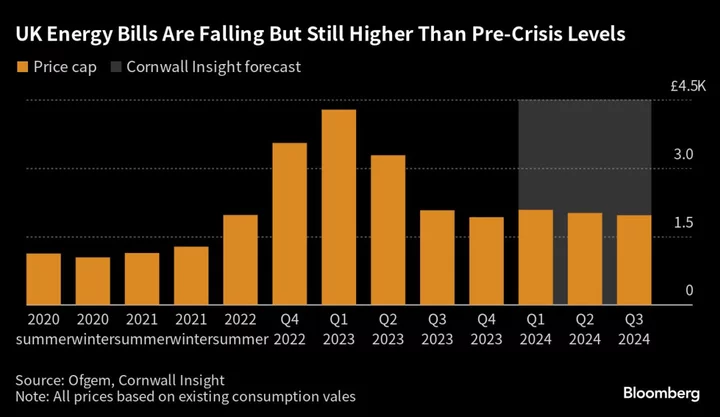UK energy bills are set to fall in October but with fresh increases expected again by January it’s raising the question of whether now is a good time for households to switch to a fixed tariff to fend off future price rises.
Wholesale costs have dropped more than 50% this year and suppliers are already offering fixed deals to consumers at or even slightly below the current cap. The UK’s second biggest supplier Octopus Energy Ltd is offering a tariff that’s 6% below the price cap, but only to existing customers, according to consumer advice website MoneySavingExpert. For those looking to switch, So Energy Trading Ltd, has a fixed tariff which is 1% less than the price cap and gives certainty for 12 months.
By the start of winter, the average dual-fuel energy bill will drop below £2,000 ($2,522.8) a year for the first time since April 2022 — but the market remains fragile. The lack of Russian pipeline gas in Europe means higher global competition for replacement supplies — mainly liquefied fuel delivered by sea from the US, Qatar and others. And the possibility of extended cold weather this winter also adds risks, as higher heating needs would boost demand for gas.
“Based on current predictions, if any firm offers a fix for under the July price cap, that looks a decent deal,” MoneySavingExpert.com founder Martin Lewis said. The level was £2,074 for the three months from July.
Regulator Ofgem is advising consumers who are thinking of fixing their tariff to “weigh up all the facts and consider what is most important to them, whether that’s the lowest price, or the certainty of knowing exactly what they will pay each month.”
Here are the most important factors to consider:
Weather
Last winter, temperatures were much milder than normal, this reduced some demand for heating and helped Europe and the UK manage supplies despite losing a lot of the flows from Russia. Forecasts for this coming winter show it will likely be colder than last year, around 2C on average for October and November.
Winter Storage
Underground gas inventories provide some cushion to supply peak demand in winter. Storage levels are currently much higher than normal levels for this time of year, but capacity is limited and isn’t designed to cover consumption in full. In addition, the UK has very little storage compared to its European peers.
Gas by Boat
With the loss of Russian pipeline gas, Europe turned mostly to liquefied natural gas imports from the US and other suppliers. This leaves markets vulnerable to price spikes and bidding wars with Asian buyers. This volatility was exemplified earlier this month when intraday prices rose more than 40% in Britain and Europe on fears that supply could be restricted by strikes at several key LNG facility in Australia. Some of those fears have since subsided, but the market is still watching continuing labor talks.
Trader Expectations
Traders are pricing future contracts for gas with an expectation that costs will remain high and increase further in 2024 and 2025. This trajectory is based on a range of factors like future demand trends, global gas infrastructure projects and longer-term contracts.
--With assistance from Elena Mazneva.

